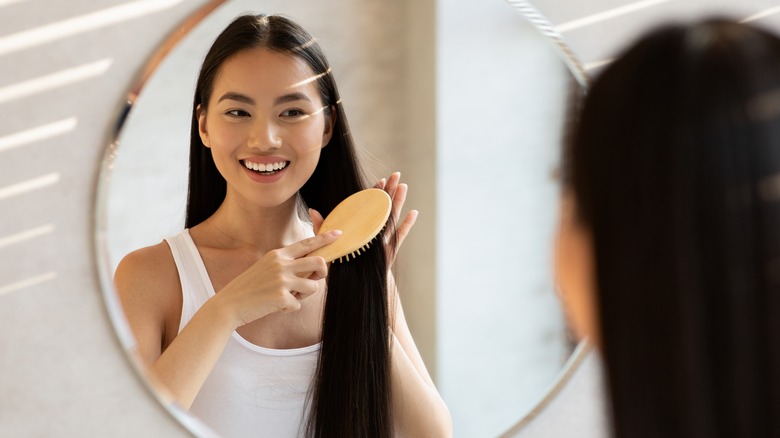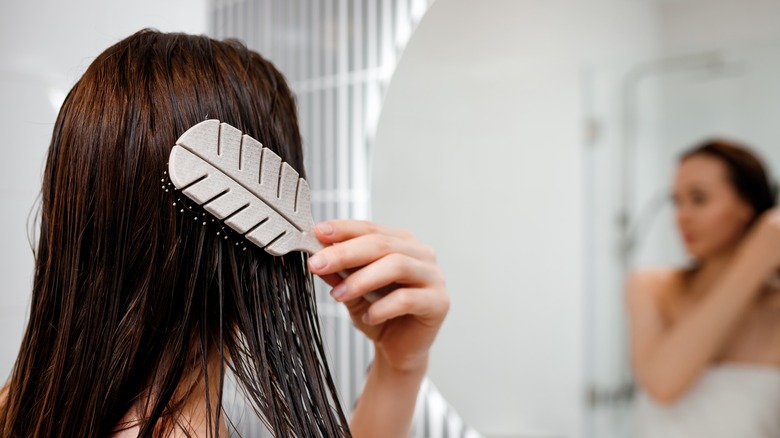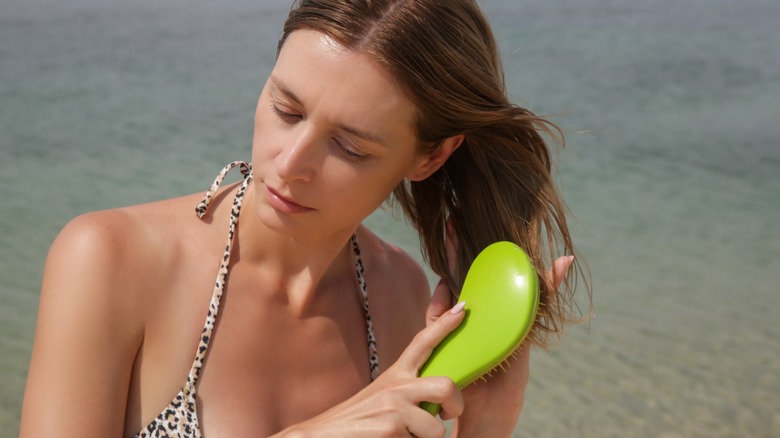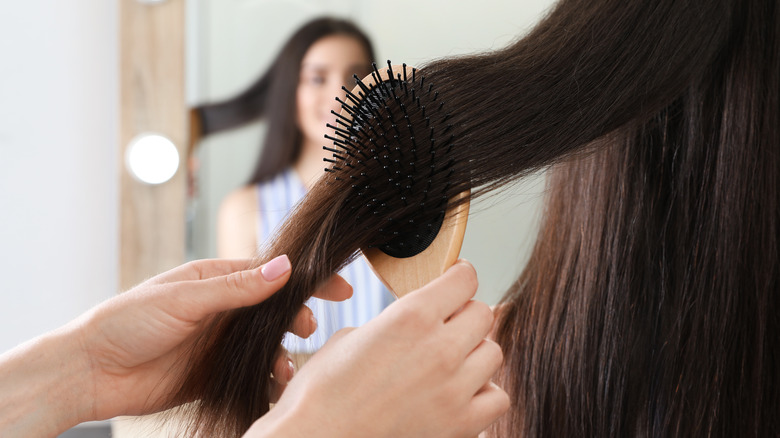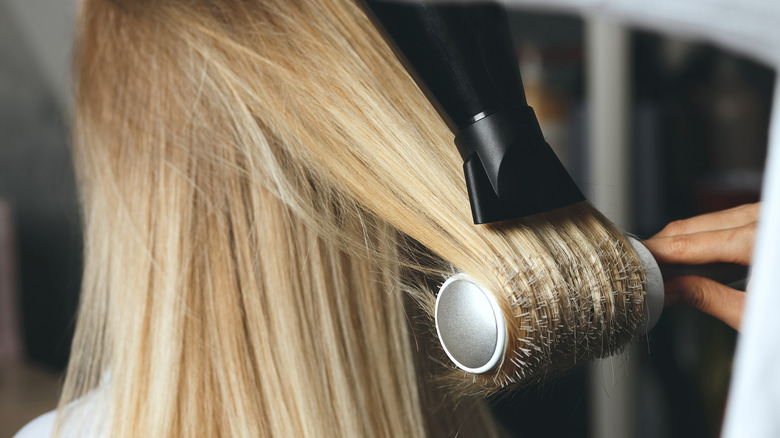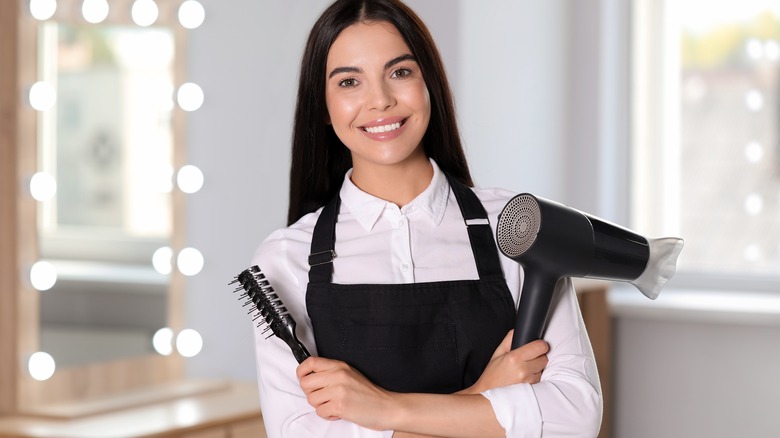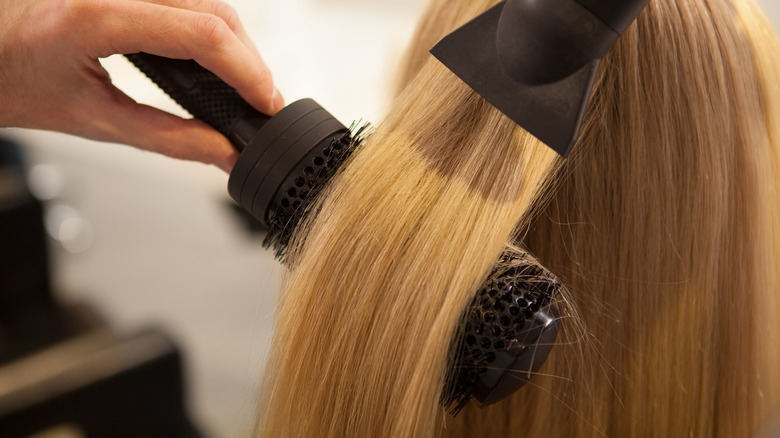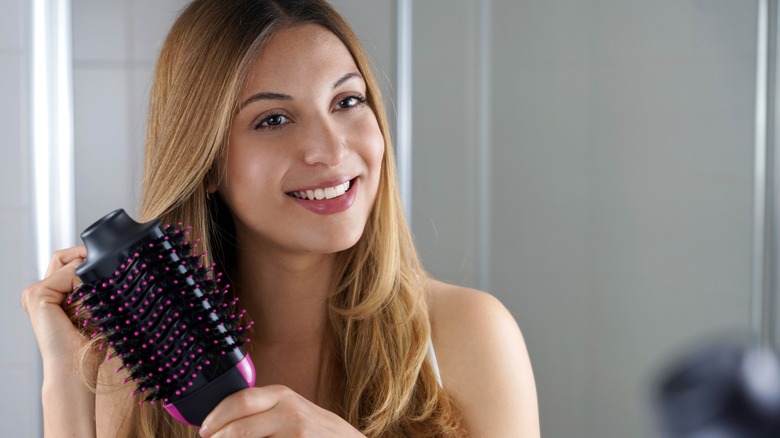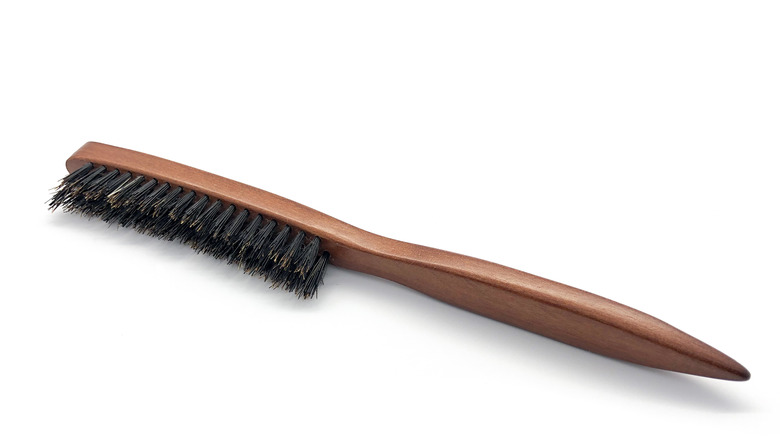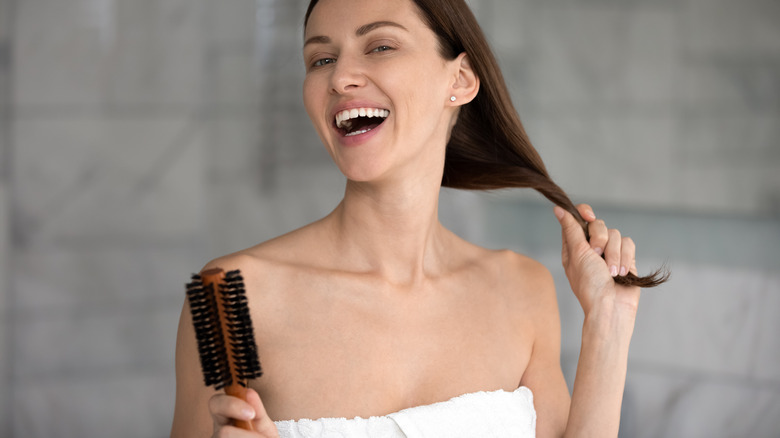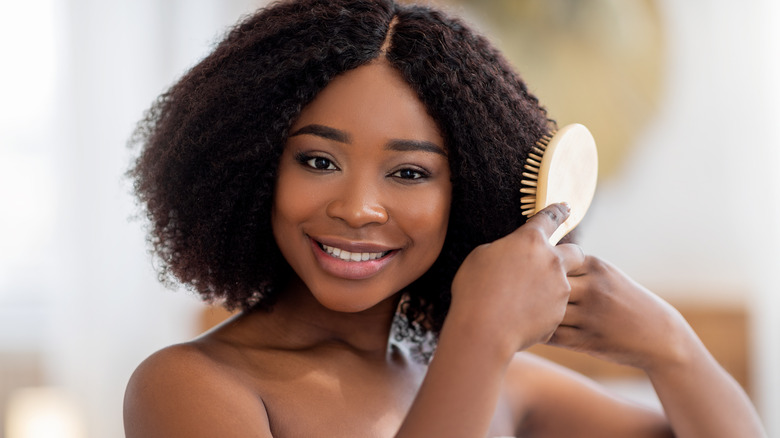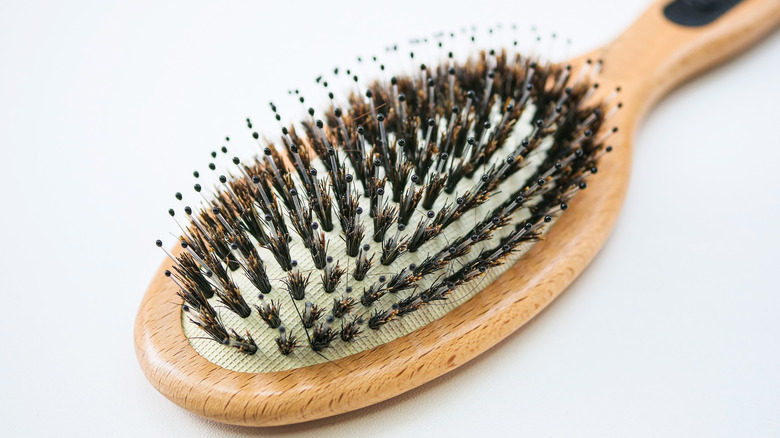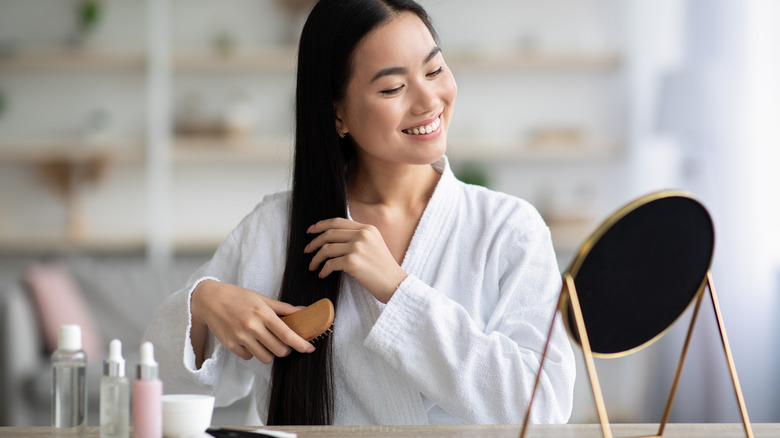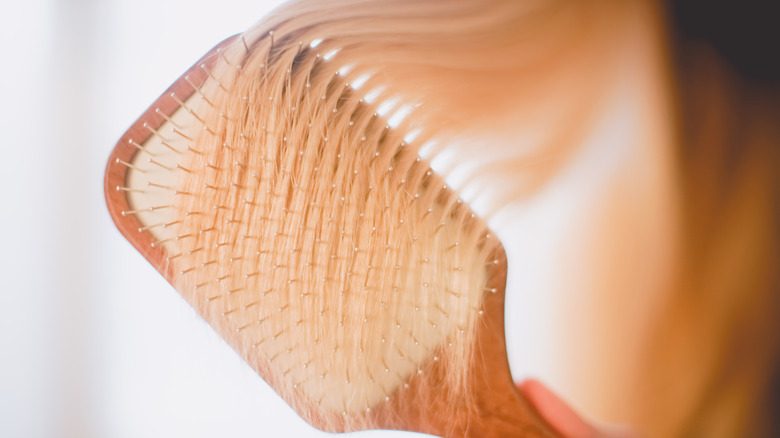Your Ultimate Guide To Hairbrushes (& When You Should Use Each Type)
You know how important it is to use the right shampoo and conditioner for your hair type. Your haircare line-up includes styling products and tools that work for your hair, too. What about your brush? Lucky for you, we have your ultimate guide to hairbrushes detailing who each type is best for.
As for hairbrush types, our picks go way beyond simply plastic versus natural bristles. You have brushes for wet or dry hair, brushes for curly or straight hair, brushes to blow dry, and brushes that smooth. There are even hairbrushes for every hair type, from fine and thin to thick and wavy. If your hair has issues or you feel it isn't acting like its best self, it could be due to the hairbrush you are currently using. Determining which brush you need and how best to use it in any hair situation will keep your locks looking groomed, healthy, and gorgeous.
The detangler
Detangler hairbrushes come in a variety of shapes and sizes. These can be picks with long plastic teeth, which work well on detangling thick and curly hair types. Other detangling brushes have flexible plastic bristles with ball tips, perfect for thinner hair and those with a more sensitive scalp. And others have plastic bristles without the ball tips designed for use on all hair types.
Made for use on both wet and dry hair, detangler brushes make it easier to work through wet or tangled strands for a pain-free brush out. Wet strands are more prone to stretching and breakage, according to the American Academy of Dermatology (AAD). Using a detangler brush is gentler on hair and helps to reduce breakage, split ends, and frizziness for smoother-looking hair.
When using a detangler, start by applying a detangling product or leave-in conditioner made for your hair type to wet locks. Next, begin gently working through the hair, beginning at the ends and working your way up to the roots.
The wet hairbrush
Similar to the detangler hairbrush, the wet hairbrush has fine, flexible bristles that work easily through strands. But this type of brush has an ergonomic shape that fits snugly into the palm, making it a great option for use in the shower with wet hands, though you can use it outside the shower, as well. Another wet brush option is the shower hairbrush. Much like the wet hairbrush, this version has vents, making it dry out faster, so you can keep it in the shower.
The wet hairbrush is well-suited to those with medium to thick hair, hair that is coarse, and hair that is curly or textured hair. Those with delicate or fine strands will want to take extra care when brushing wet strands to prevent breakage. To use the wet brush, start toward the ends of your hair and, working in sections, work your way up to your scalp.
The cushion hairbrush
This hairbrush type has a soft, cushiony base with stiff bristles, typically made of plastic or wire. There are many uses for the cushion brush: It works on a variety of hair types and is best for short to medium lengths of hair.
When used for styling, usually in combination with a blow dryer, the cushion hairbrush adds a look of smoothness to strands while lending volume to the hair. Other uses for this brush type are to stimulate blood circulation on the scalp and help reduce the appearance of dandruff.
Another bonus to using the cushion brush may be thicker-looking hair. A study published in ePlasty reported that regular scalp massages could improve the appearance of thinning hair. To perform a scalp massage with a cushion brush, work the brush over the scalp and through your strands. This is best done before washing or going to bed, as it works natural oils through hair and can make the hair look greasy.
The thermal hairbrush
Designed to be used with a blow dryer, the thermal hairbrush is made with a material that will hold heat, like ceramic, titanium, or tourmaline. This speeds up the drying process and diminishes the likelihood of heat damage to strands. Bristles on this brush type are nylon to reduce frizz and boost shine, and the brush is vented for airflow. You can get thermal brushes that are either a paddle brush or round brush shape, and many have a rubberized handle for grip and ease of handling while styling.
All hair types can use a thermal brush. When using a thermal brush to style your hair, you can create a smooth, sleek look or opt for bouncy waves and curls. Using the brush at your roots with your blow dryer will create lift and volume, a great solution for limp locks. To straighten hair with a thermal brush, run the brush down a section of hair from roots to ends while applying heat.
The vented hairbrush
While the thermal hairbrush is best suited to drying wet hair with less damage, a vented hairbrush is what you are looking for if you want a quick blowout. While it will always take longer (like, a LOT longer) to style soaking wet strands versus strands that have done a bit of air drying or been rough dried (blowdrying hair slightly with fingers to remove excess moisture), a vented brush will speed up the process. The vents in the brush allow the heated air to move through the brush and strands, getting to all layers of your hair.
And vented hairbrushes are useful in cutting down on static in your hair. Those vents that make your blow dry speedier are also great for eliminating the static that makes your hair stand on end or creates a frizzy look. Opt for a vented brush if you tend to need to dry your wet hair in a rush, if you typically have frizz, or in the cold weather months when static is more a thing.
The round hairbrush
Everyone has a round brush lurking somewhere in their haircare arsenal, right? These babies are the move for creating a variety of blow-dried looks. You can choose from large round brushes, medium round brushes, and smaller round brushes. Round hairbrushes come with boar bristles, nylon bristles, or a combination of both. If you have thick or coarse hair, opt for a nylon bristle brush. Those with medium-thickness or straight hair should choose a boar bristle round brush. This brush type works best on medium to thicker hair types and can leave thinner hair looking limp and flat.
When using a round brush in combination with a blow dryer to style your hair, pick a larger brush for creating a smooth look and a smaller brush for bouncy, more defined curls and waves, depending on your hair length. Round brushes are good for adding a bit of curl to the ends of hair, too. If you want to use a round brush on thinner hair, stick to the ends so you don't lose volume at your roots.
The straightening hairbrush
Not your typical hairbrush, think of the straightening hairbrush as an electric brush with bristles or flat iron meets paddle brush. Yep, you plug this baby in, so it's a heated styling tool that acts as a brush. The beauty is that a straightening hairbrush gives you the control of a round brush or paddle brush, with the ease of a built-in blow dryer, plus none of the damage or breakage of a flat iron. Basically, hair straightening perfection. This brush can be used on all hair types and is gentle enough for fine strands.
Straightening hairbrushes are designed for use on dry hair and can be damaging to wet or damp hair, so always start with completely dry strands. Starting at the roots, run the straightening brush through to the ends of the hair. Lifting hair at the roots will create volume at your crown. A few passes over each section should do the trick. If you still prefer your beloved flat iron for straightening, just be sure to use the right flat iron for your hair type.
The teasing hairbrush
Think the teasing hairbrush left with the '50s? Think again. While you might not see this type of brush used as commonly as a paddle brush or round brush, it does have its purposes. Teasing brushes were invented to create the look of volume at the crown of the head, producing a fuller look for thin or limp hair. People who have super fine hair or who have hair loss often find a teasing brush super helpful.
This brush type is long and narrow, with dense bristles and a pointed tip. Similar to the rat tail comb, the pointed end can be used to create sections of hair. To use this hairbrush, isolate a small section of hair and brush in a backward motion from approximately one inch away from the scalp toward the scalp. Lay the section down and smooth the top layer of the section with the brush to create a seamless look. Concentrate on the crown of the head.
The boar bristle hairbrush
Possibly the hairbrush best suited to all hair, the boar bristle brush is loved for its ability to create smooth, shiny, healthy-looking locks without causing damage to your strands. You can find boar bristle hairbrushes in paddle brush, round brush, and smaller teasing brush styles. Boar bristles are soft and the boar bristle hairbrush works well on all types of hair, including fine hair, thin hair, and delicate hair, and is even suitable for use with hair extensions.
Boar bristle hairbrushes distribute the natural oils found on the scalp throughout the strands of hair, making locks look glossy and full. This brush type is also perfect for smoothing the hair when creating a sleek look or updo. Use your boar bristle brush daily to revitalize the scalp and remove loose hair strands without pulling or breaking healthy hair. Always use your boar bristle hairbrush on dry hair that is relatively tangle free.
The nylon bristle hairbrush
Nylon bristle hairbrushes are easy to find, come in a wide variety of shapes, sizes, and styles, and are a super affordable option. Nylon bristles are made from synthetic materials and are designed to detangle strands, smooth the hair, and reduce static and frizziness. There are nylon bristle brushes for all hair types, but this brush type works best on medium to thick and coarse hair.
Synthetic nylon bristle brushes are much like boar bristle brushes in how they behave on your hair and their uses. But nylon bristles are a bit stiffer than boar bristles, which is better for working through thicker hair and hair prone to frizz. Nylon bristle brushes are good at navigating tangles, as the flexible bristles glide over tangles rather than getting stuck. This bristle type also makes for a great styling tool when blow drying and is perfect for dry brushing, redistributing natural hair oils, massaging the scalp, and removing loose strands of hair.
The mixed bristle hairbrush
The best of both worlds in a hairbrush? Absolutely! This type of hairbrush combines natural boar bristles with synthetic nylon bristles to meet the needs of pretty much any hair type, though the mixed bristle brush tends to perform best on long hair and those with medium to thick hair types.
If you are wondering why you'd need to mix bristles, think of it this way: You get the shine-enhancing effects of a boar bristle brush with the detangling attributes of the nylon bristle brush. In a nutshell, this brush is the boar bristle brush that works best if you have thicker hair. It has all of the scalp massaging, oil distributing, loose hair removing qualities of the boar bristle hairbrush, along with the ability to get through all layers of hair. But remember, when using a mixed bristle hairbrush, as with a boar bristle brush, only use this type of brush on dry hair for best results.
The curved hairbrush
A hairbrush that is truly for everyone, the curved hairbrush works on all hair types, including fine, thin, thick, and curly hair, and is a favorite of those with shorter styles. The difference is in the shape. The curved design of the brush is meant to fit the natural curves of the head, allowing the user to easily work through wet or dry strands. Curved brushes are typically vented and made with plastic bristles (though there are options with mixed bristles), so they dry out easily and are great for detangling, as well as styling.
Another advantage to using a curved brush when styling with a blow dryer is its ability to grab a larger section of hair at one time due to its curved feature. This allows you to get through your entire head in less time, and it works on both long and shorter styles, creating a smooth, straight look.
The paddle hairbrush
And last but not least in our ultimate guide to hairbrushes is the classic paddle brush. Most loved by those with straight, long, thicker hair types, the paddle brush features a wide, flat base and can be made with boar bristles, nylon bristles, or a combination of both. The paddle hairbrush is excellent at making hair feel smooth and straight. It also creates a shiny, healthy appearance. If you are using a paddle brush on fine hair, opt for the boar bristle variety, as it will be gentler.
To use the paddle brush, gently run through sections of hair from roots to ends, gliding carefully over tangles and knots. This brush also creates a super sleek, straight look when used with a blow dryer, giving only a slight curve to ends, as opposed to the round brush. If you are looking to splurge on a hairbrush, a high-quality paddle brush is the best choice and makes an excellent addition to your haircare kit.
